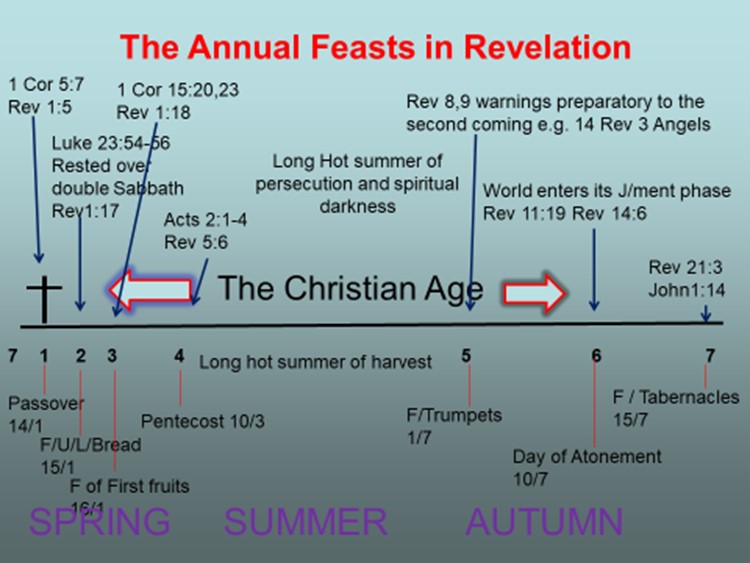
The Jewish Calendar Overlays Revelation.
The book of Revelation follows the Daily/ yearly pattern of the Hebrew Sanctuary service. The first half of the book (Rev 1-11) is modelled on the ‘Daily” service ( called the Tamid) which involved the morning and evening sacrifice of a lamb. This signified that salvation was always available. The theme was intercession. The second half of the book (chapters 12-22) is modelled on the yearly service – the Day of Atonement, ( called Yom Kippur) and involved judgment. In addition to this, the Hebrew annual festival calendar is also overlaid over the book and contributes to the ‘bone’ structure. The header is a slide from a PPT presentation I made a few years ago. All 7 of the annual feasts (the yearly Sabbaths mentioned in Col 2:16-17 as shadows of the cross,) are referred to in Revelation.
As already noted, each section of Revelation begins with a sanctuary scene. The 7 sanctuary scenes each are systematically attended, in order of the calendar, by one of the annual ceremonial Sabbaths. Revelation 1:9-20 uses the Passover which included The Feast of Unleavened Bread and the Feast of First Fruits. Revelation 4 & 5 refers to Pentecost, 8:2- 6 the Feast of Trumpets. 11:19 mentions the beginning of the Day of Atonement. 15:5-8 the progression of the Day of Atonement and 19:1-10 the closure of the Day of Atonement. Revelation 21:8 refers to the Feast of Tabernacles.
Every one of these was fulfilled by Jesus. E.g. Jesus was born during the Feast of Tabernacles (easily provable from Luke’s Gospel,) he died at the exact time (day and hour) of the sacrifice of the Passover lamb. He spent the Feast of Unleavened Bread in the tomb, and rose from the dead on the Feast of First Fruits. The Holy Spirit was poured out on the Feast of Pentecost and His name was proclaimed. He fulfilled the Day of Atonement on the cross and will again ‘Tabernacle’ with us in the new earth (Revelation 21:3.)
As you can see from the diagram above this calendar can also be superimposed over the Christian age from the cross to the Second Advent.
What is the importance of all this Sanctuary information? Why does the book of Revelation place so much value on it? Some other related question we could ask are: Where does God live? Does God need judgment books (scrolls)? Does he need to keep a written record? Does God sit on a chair (throne)? Can Omnipresence be limited to one limited space (a chair/throne)? Do angels actually have wings?
God is omnipresent (everywhere at once.) Read Psalm 139:5-10. However, He has chosen a specific place to meet with the angels, with non-fallen worlds…and with us when we will finally be with Him.
As I said in an earlier post, scientists tell us we will soon be able to communicate with dolphins! What would we say to them? How would we tell them about things on land? We could only talk to them with things they would understand: fish, sand, waves, water, bottoms of boats etc.
How does God communicate with us? He uses concepts that our limited finite minds can understand. Thrones represent rulership, wings represent flight, judgement books represent records being kept and so on.
The earthly Hebrew sanctuary, we are told,(Hebrews 8:1-5) was modelled on the heavenly one as “a shadow,” a faint reflection of the vastness and glory of the heavenly sanctuary which is the abiding place of the King of Kings, where 100 million angels stand before him (Dan 7:10). That temple: filled with the glory of the eternal throne where seraphim, its shining guardians, veil their faces in adoration. Yet important truths concerning the heavenly sanctuary and the great work there carried forward for man’s redemption were taught by the earthly sanctuary and its services. Revelation (among other places) is clear on the continued importance of us embracing this theme even in the New Testament. Jesus said He was the embodiment of the sanctuary.(John 2:19 etc)
God dwells in His Sanctuary in Heaven; “the true tabernacle which the Lord erected, and not man” (Heb. 8:2). The earthly sanctuary was “the copy and shadow” of that sanctuary (Heb. 8:5). “The dwelling place” of Yahweh 1 Kings 8:30. “For He looked down from the height of His sanctuary; from heaven the Lord viewed the earth” (Psalm 102:19).
Not only the Book of Revelation, but the entire New Testament is full of sanctuary terminology and imagery. The book of Revelation cannot be understood without appreciating how the Hebrew Sanctuary Service and all its symbolism and typology over lays the entire book of Revelation. As we have seen the structure of the book is based on the daily and yearly services of the Sanctuary. This Sanctuary service provides the bone structure upon which the entire 22 chapters of Revelation are built.
